International Programs
Past Programs in Russia
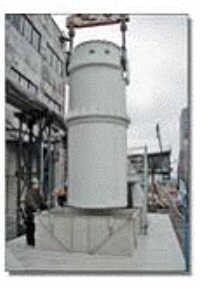
Prototype Container TUK-108/1 at RTP Atomflot Murmansk, Russia, 2001, the first 40-ton metal-concrete, dual-purpose transport and storage cask for Russian naval spent nuclear fuel.
EPA's partnership with Russia on environmental issues has spanned the last several decades, and led to signficant environmental results. EPA provided leadership in implementation for the following areas and projects in Russia:
- Addressing Radioactive Waste
- Hazardous Waste
- Mercury
- Risk Assessment
- Photo Gallery of EPA's Past Work in Russia
Addressing Radioactive Waste
Murmansk Initiative and London Convention
In 1993, the Russian Federation requested technical assistance to expand and upgrade their existing liquid radioactive waste treatment facility at a Murmansk shipyard, RTP “Atomflot,” The Russian Federation did not have the technical capacity to treat liquid radioactive waste from nuclear icebreakers and submarines, and therefore could not sign Amendment 5 of the London Convention (prohibiting the disposal of radioactive waste in the ocean).
To support this goal, an EPA team established a partnership with Norway and the Russian Federation to develop the needed capacity for treatment and storage of liquid radioactive wastes. This work fostered the Russian Federation’s formal acceptance of the ban, announced at the 27th Consultative Meeting of the Parties to the London Convention on 28 October 2005.
Arctic Military Environmental Cooperation Program (AMEC)
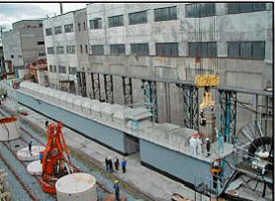
Hot Testing at Transshipment Storage Facility, FGUP Atomflot, Murmansk, August 2003.
The Arctic Military Environmental Cooperation Program (AMEC) helped to enhance military collaboration in environmental protection of the Arctic. From 1997 to 2005, EPA assisted Russia in meeting the objectives of the START II Agreement, through activities associated with the Soviet nuclear submarine dismantlement program. In particular, EPA contributed to the development of specific infrastructure for the decommissioning of Russian ballistic missile nuclear submarines.
Including information exchanges as well as technology development and implementation, the AMEC Program became the first multilateral cooperation of its kind. This program was later expanded to address storage and transportation of high-level solid radioactive waste (primarily spent nuclear fuel [SNF] from naval reactors), managed by the Departments of Defense of the United States, Russia and Norway, and later the United Kingdom.
EPA-managed projects included the design, fabrication, testing, and certification of the first 40-ton metal-concrete, dual-purpose transport and storage cask for Russian naval spent nuclear fuel. Today, 106 of these casks are in daily operation, either transporting fuel to the storage facilities or for temporary storage. The project also included the construction of the first mobile cask conditioning system to allow for long-term temporary storage of spent nuclear fuel.
Hazardous Waste
AMEC Hazardous Waste
Between 2005 to 2008, working with the Arctic Military Environment Program (AMEC), EPA developed the first cooperative program with the Russian military to address the management of toxic and hazardous wastes, assisting Russia in meeting the objectives of the Stockholm and LRTAP Conventions.
This work included the development of a Cleaner Production training program at military bases in the Arctic (2006), under which 24 model demonstration cleaner production projects were implemented on the topics of pollution prevention, waste minimization, recycling, energy efficiency, and sustainability.
Another project focused on the development of a model demonstration facility for cleaning and compacting drums containing hazardous waste. This project was designed to address an overwhelming problem of legacy hazardous waste accumulated in the drums which are scattered throughout the Russian Arctic.
In partnership with the US DoD and Russian Ministry of Defense, EPA established a model mercury lamp recycling facility at Navy Yard 10, Murmansk Region. The facility is capable of recycling a wide variety of mercury-containing products, such as thermometers, barometers, switches and stabilizers.
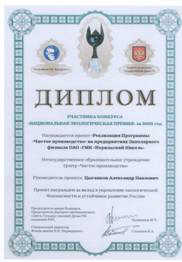
The Polar Branch of Norilsk Nickel Company was awarded a Diploma from the Environmental Committee of the Russian Duma and the Vernadsky Fund for implementing this program.
Cleaner Production Project at Polar Branch of Norilsk Nickel Company in the Arctic
The ACAP Cleaner Production Project included the development of three cleaner production training modules. Participants were responsible for the development and implementation of model environmental projects resulting in economic benefits to their company. As a result of this project, 74 employees were trained and certified as Cleaner Production Advisors, 274 environmental technical projects were developed, and 87 environmental projects were implemented, achieving $8.6 million in economic gains.
Examples of measurable environmental achievements included:
- Reduction in fresh water consumption: 7.9 million cubic meters
- Reduction of waste discharge: 3.4 million cubic meters
- Reduction in electrical energy use: 14.9 million kilowatt hours
- Reduction in diesel oil use: 210 tons
- Reduction in discharge of heavy metals and their oxides into the atmosphere: 850 tons
This project was jointly implemented in 2002-2005 by the Norwegian Society of Chartered Engineers, USEPA, and Russia under the Arctic Council's Arctic Contaminants Action Program (ACAP).
Inventory of Unaccounted Sources of PCBs and Obsolete Pesticides in Nenets Autonomous Region
In June 2005, EPA played a leadership role in an inventory of PCBs and obsolete pesticides in Nenets Autonomous Region as part of our work under the Arctic Contaminants Action Program (ACAP). Activities were organized in three selected indigenous villages, Anderma, Nelmin Nos and Krasnoe, in the Nenets Autonomous Region (NAO). As part of this activity, the local population was trained to identify sources of PCBs, obsolete pesticides and other toxic and hazardous wastes. A special training course on safe food consumption was developed for use in schools and community education programs. Samples were collected from local landfills to test for PCBs, pesticides and mercury-containing compounds. In some households, POPs contaminated food containers were replaced with new food storage containers. This project was implemented in cooperation with the Russian Association of Indigenous People of the North (RAIPON) and the Northwest Public Health Research Center in St. Petersburg, Russia.
Workshops on management of abandoned drums in Chukotka Autonomous District, Russia
In 2009, EPA hosted a workshop for Alaska and Russian native technicians working to remove abandoned drums in their rural Alaska and Chukotka villages. The workshop covered topics such as health assessments, outreach, hazardous materials handling, and emergency response training. Representatives from 40 Tribes around the state attended the workshop, and five Russian delegates received a technician certification. This workshop followed up on 2007 and 2008 training sessions in Chukotka indigenous villages conducted by the EPA Alaska Operations Office and Office of International Affairs, in partnership with the Alaska Department of Environmental Conservation, Aleutian Pribilof Islands Association, Alaska Native Tribal Health Consortium and University of Washington.
Mercury
Mercury Chlor-alkali Partnership (2005-2010)
Under the UNEP Global Mercury Partnerhip, EPA developed a successful partnership with the Russian chlor-alkali industry to reduce the consumption and release of mercury into the environment. The program developed and implemented demonstration projects to reduce mercury releases and consumption as part of chlorine production in Russia.
All Russian chlor-alkali production facilities participated in the partnership initiative. Since the establishment of the partnership in 2004, total mercury releases from the chlorine production were reduced by 53%. Additionally, the Russian Association of Chlorine Manufacturers, Ruschlor, developed recommendations to improve legislation and standards for the management of mercury-containing waste.
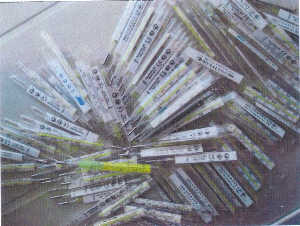
Thermometers collected for safe disposal.
Mercury Thermometers Project in the city of Barnaul, Altai Krai
To reduce potential contamination, over 2,600 mercury-containing thermometers were collected, recycled and replaced with safe electronic thermometers at five children's hospitals in the city of Barnaul (in the Altai Krai region of Russia). The mercury collected from these thermometers was placed in long-term storage at a hazardous waste treatment, storage and disposal facility in the Tomsk Region (Tomsk Polygon).
Completed in 2009, this demonstration project was managed by the EPA and implemented by the Institute "Progress", the Ministry of Health of Altai Krai, the Directorate of Pharmaceutical Activities of Altai Krai, Altai Krai Branch of The Children's Fund, and in cooperation with UNEP Global Mercury Partnership on Products.
Risk Assessment
Environmental Capacity Building for Risk Assessment and Management
From 2004-2005, EPA supported the Environmental Defense Fund (EDF) ![]() in a project on Environmental Capacity Building for Risk Assessment and Management in Russia and former Soviet states. Within Russia, EDF helped local Russian experts and decision makers better assess their regulatory system for local air pollution and the risks to human health. A manual and case studies on Environmental Valuation and Benefit-Cost Analysis were developed. Regional experts and policymakers were trained on human health risk assessment methodologies in Russia. In February 2008, legislation was enacted establishing Risk Assessment as the key regulatory control for environmental quality standards affecting residential areas in Russia.
in a project on Environmental Capacity Building for Risk Assessment and Management in Russia and former Soviet states. Within Russia, EDF helped local Russian experts and decision makers better assess their regulatory system for local air pollution and the risks to human health. A manual and case studies on Environmental Valuation and Benefit-Cost Analysis were developed. Regional experts and policymakers were trained on human health risk assessment methodologies in Russia. In February 2008, legislation was enacted establishing Risk Assessment as the key regulatory control for environmental quality standards affecting residential areas in Russia.
Photo Gallery of EPA's Past Work in Russia
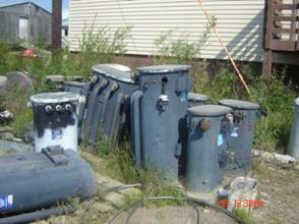
Obsolete transformers in a Gwich’in village in Alaska. Community-based Model Demonstration Project for PCB mitigation in the Arctic. Managed by Gwich'in Council International (GCI). (August 2005) |
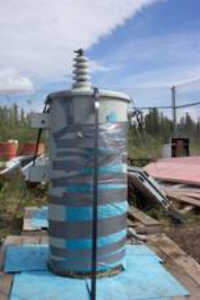
Obsolete transformer banded to wooden pallet with absorbent material to prevent leaking, and ready for shipment. (Beaver, AK, July 2006) |
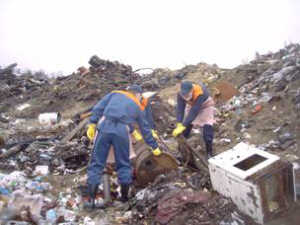
Waste site near the Village Krasnoe, Nenets Autonomous District. Local residents were trained on sample collection techniques. (October 2005) |
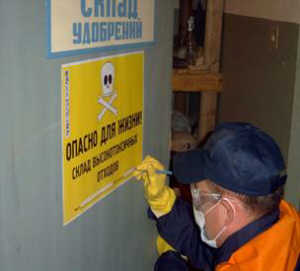
The pesticides were repackaged and labeled, and warning signs were placed on the door of the warehouse. Sign: Pesticides storage. Danger! Storage of highly toxic chemicals. (Village Krasnoe, Nenets Autonomous District. October 2005) |
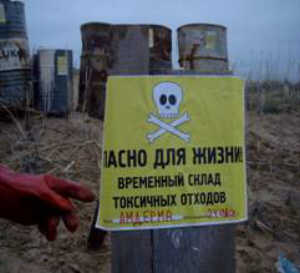
Sign: Danger, temporary storage of toxic waste. Village of Anderma, Nenets Autonomous District, (October 2006) |
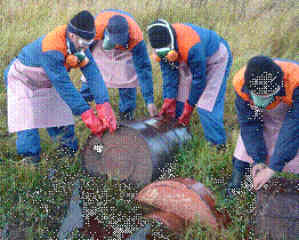
Model demonstration project on drums removal and containment. (Village Krasnoe, Nenets Autonomous District, Russia, 2006) |
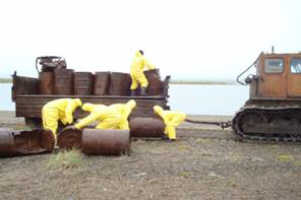
More than 2000 drums were removed from the Lorino Bay and the road connecting communities of Lorino and Lavrentia, in the region of Chukotka. (August 2007) |

AMEC Mercury products treatment facility. In partnership with the USDoD and Russian Ministry of Defense, a US-Russia technical team established a model mercury lamp recycling facility at Navy Yard 10, Murmansk Region. The system is capable of recycling a wide variety of mercury-containing products, such as thermometers, barometers, switches and stabilizers. (Navy Yard 10, Polyarny, Murmansk Region, 2008) |
Back to: Eurasia
Contacts
For additional information about EPA's work with Russia, contact:
Office of International and Tribal Affairs (2610R)
U.S. Environmental Protection Agency
1200 Pennsylvania Ave., NW
Washington, DC 20460
Contact Us
